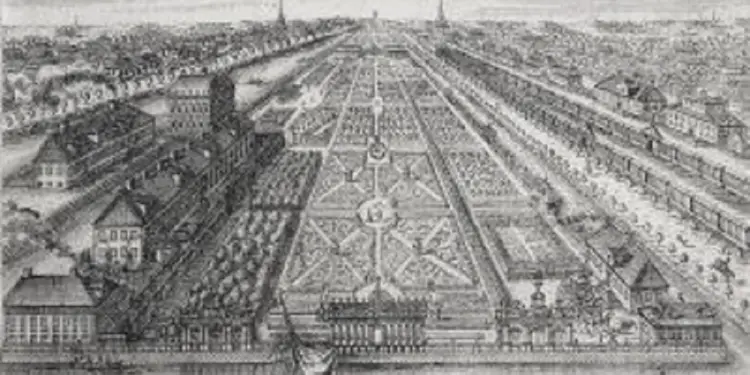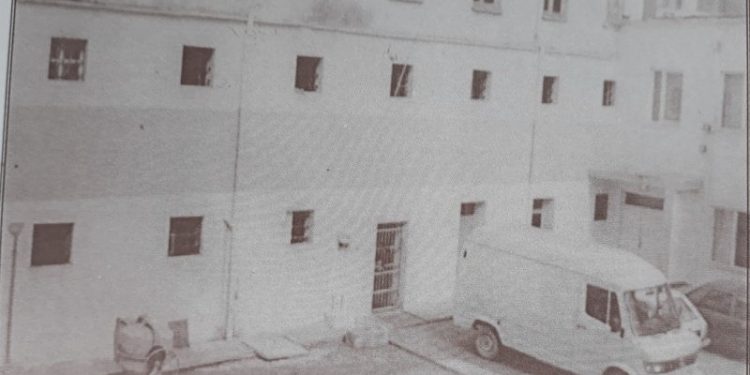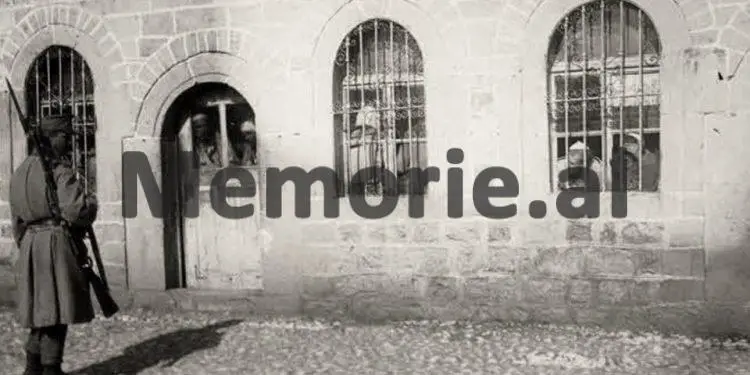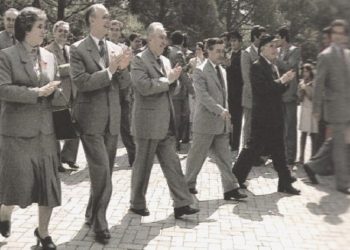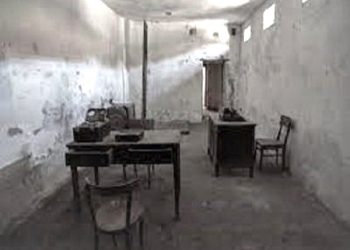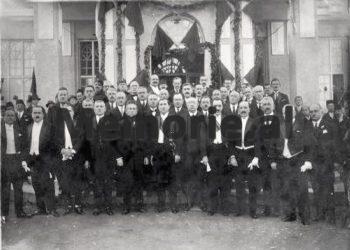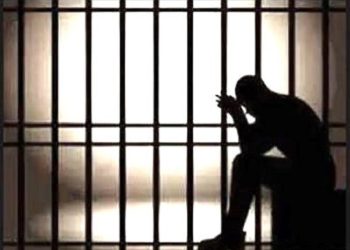By Kastriot Dervishi
– How were the secret prisons of the communist dictatorship organized, in war situations…?! –
Memorie.al / In the years 1944-1946, the prisons and camps where the political convicts of Enver Hoxha’s communist regime were held were under the Directorate of People’s Protection (operational structure of the Ministry of National Defense), while the ordinary ones, under Directorate of the People’s Police in the Ministry of Internal Affairs. Partisans left from the War, but of the most loyal part, were an integral part of the prison staff. The communist regime had not yet established trust in the People’s Police to administer the prisoners. Prisons throughout the country served as a place of punishment. They were also suppliers of labor camps, which the regime set up from time to time throughout the country.
In April 1947, with the new organization of the Ministry of Internal Affairs, within the Directorate of the People’s Police (DPP), the Department of Enforcement of Criminal Decisions (DZVP) was created, consisting of the section of Reeducation (prisons), the section of Prisoners of War and later the Greek Refugee section. In 1947, there were a total of 18 prisons in the country, 8 for “enemies of the people”, 7 for ordinary and 3 were mixed. At first, the one- or two-digit numbering system of prisons and camps was used in the designations. The data we have inherited is quite small, often contradictory. For this reason, a complete registration of them according to numbers was impossible.
Prisons Regulations 1946
An incomplete regulation of 1946 has survived to our days, which has neither a date nor an end to it. It consists of 69 articles. The prisons were administered by the Ministry of Internal Affairs. According to the regulation, prisons were divided for ordinary criminals and for “enemies of the people”. Prisons were ordinary and political. These were separated from each other. The rooms where the investigation took place were separate from the place where the punishment was carried out. The women’s and youth’s rooms were separated from the other convicts. The convicts were organized by the director of the prison, who dealt with the administration. The prison commander dealt with the military side. The director gave the following measures to the convicts: warning, restriction of correspondence, restriction or loss of the right to visit family members, to send items, to use money. For these, you could suffer days in the dungeon or transfer to another prison.
1950’s platform
After a “rich” experience in the years 1945-1950, in which prisoners were “systematized” in certain prefecture centers, on April 8, 1950, the Minister of Internal Affairs, Mehmet Shehu, approved the platform for prisoners. This platform aimed at the distribution of prisoners throughout the country. According to her:
- For those who came from the working, peasant and poor classes. For ordinary elements when the sentence was under 15 years, the sentence had to be served in the nearest prison, near the place of residence. When the sentence was more than that, in another prison and the prisons of Burrel and Gjirokastra. Political prisoners under 10 years could serve their sentence in the nearest prison. Over 10 years in another prison or in both of the aforementioned prisons.
- For the elements that flowed from the upper classes, kulaks, merchants and intellectuals. For ordinary convicts under 10 years, the sentence was imposed at the nearest place of residence. With 10–15 years, in a higher prison and over 15 years, in the two prisons defined above (Burreli and Gjiroksatra). For political convicts, when the sentence was up to 7 years, the sentence was placed near the place of residence. With 7 years, in the nearest prison. Over 10 years in prison, the sentence had to be served in the prisons of Burrel and Gjirokastra. For the prisoners, a division scheme was made in the prisons, according to their origin.
- In Berati prison: Skrapari, Kuçova, Lushnja, Berati.
- In Vlora prison: Vlora, Fieri.
- In Gjirokastra prison: Gjirokastra, Saranda, Delvina, Tepelena, Përmeti.
- In Korça prison: Korça, Kolonja-Leskovik, Pogradeei.
- In Durres prison: Durresi, Kavaja, Shijaku.
- Elbasan prison: Elbasan, Peqini, Librazhdi, Gramshi, Peshkopia, Shupenza.
- Tirana Prison: Tirana, Kruja, Burreli.
- Shkodra Prison: Shkodra, Lezha, Puka, Rresheni, Dukagjini, Tropoja, Kukësi.
After that, the next category was foreseen for the convicts further away from their place of residence.
Prisons Regulations 1965
After a long absence, a new prison regulation was issued, approved by ministerial order no. 01-68, dated 16.10.1965. The Ministry of Internal Affairs continued to implement the final decisions of the courts through the Department of Camps and Prisons, under the Directorate of the People’s Police. Prisons and camps had double dependence, from the center and from the Departments of Internal Affairs of the district where they were located. The president, the prime minister, the deputy prime ministers, the members and candidates of the Political Bureau, the first secretaries and the heads of the Executive Committees of the districts where they were, the minister of internal affairs, the directorate of the Police and Security, the head and deputy of the Camps Branch were allowed to enter the prisons. of Prisons, the Minister of Justice, the President of the Supreme Court, the General Prosecutor, the district prosecutor.
“Punishment with deprivation of liberty, as a rule, is imposed in labor camps”, was the definition of Article 14. Convicts, without a final decision, those unable to work, the elderly and those who violated the Prison Regulations were not sent to labor camps. . According to this article, only able-bodied convicts were kept in the camps, a rule violated hundreds of times. Convicts were admitted to prisons and camps with the following documents: the arrest decision, the final court decision, the control report, the interview-survey of the accused, the fingerprint card, and the evidence of the penalty. The prisoners were divided into dormitories as follows:
- Those convicted of crimes against the state.
- Women, however, were kept apart from ordinary and political women.
- Convicted prostitutes were kept separately.
- Convicts with foreign citizenship.
- Convicts – 12 months.
- Convicts – 18 years.
- The convicts were former members of the APS, the Ministry of Internal Affairs, justice bodies, former soldiers, etc., when they had committed ordinary crimes.
- Elderly convicts and those with illnesses.
Convicts related by blood were forbidden to live together. Likewise, those who were convicted together for a crime were forbidden to stay in the same room. Convicts were released only when the convict served time, was pardoned by decree and released by court decision. After release from prison, the Office of Judicial Affairs was notified, for political convicts, the IV Branch of the State Security Directorate was notified, and for ordinary people, the People’s Police Directorate (together in the booklet). The fingerprint card was sent to the Central Criminal Laboratory.
Convicts who were executed were buried by the internal guards. What little they could leave, such as salaries or any income was confiscated. The corpses of convicts who died at work were not given to their families. Such a thing could only be done if a decree of the Presidium of the People’s Assembly was issued, which is really impossible. At work, convicts were divided into brigades. They carried the bag of bread, the gourd of water, and then the work tool. They had the right to benefit from a reduced sentence from work, according to decree no. 1782, dated 14.12.1953.
“Re-education” was done through command agitation, programs, wall newspaper, library, etc. During the scheduled times, in the prison yard of the camp, the loudspeaker of Radio-Tirana was placed, with music and news. But the minister could limit or prohibit the showing of films, the reading of the press, etc.
The Council of Reeducation in prisons was created with the approval of the command of 5-9 pious convicts. Its members were assigned tasks, such as: cultural, hygienic, etc. Inside the camp or prison, a kind of court was set up, consisting of 3-7 convicts. The court proposed to the command disciplinary measures against the convicts.
The “rights” of the convicts began with the state guarantee of food, soap and clothing. Convicts in prisons went out for airing twice, one hour in the morning and one hour in the afternoon. Convicts could receive food from their families. Up to 15 kg. For month, while elderly patients, up to 30 kg. Convicts could meet with their relatives once a month, for 10 minutes. They stood separated by the fence wire and the guard in the middle. The guard could interrupt the meeting if he overheard unwanted conversations. Convicts who were used as spies for their fellow prisoners, or camp command personnel, etc., or tools of the regime, could sleep 1-4 nights with their wives in a separate room. Dangerous convicts could send one letter a month, but the letters addressed to the leadership, which were “not censored”, were not included here.
Punitive measures were given to the convicts starting with: warning before the convicts, prohibition of correspondence 1–3 months, prohibition of meeting 0.5 months–3 months, isolation 3–30 days in the dungeon, sending to hard labor for 1 month. The last measure was re-conviction through another judicial process. The prisoners in the dungeon were stripped of their sleeping clothes, which were given to them at night. They could only carry the water gourd in the dungeon. Cigarettes for those who smoked were only given during meals. They were taken out from there only once a day, for personal needs and for airing for 1 hour. However, experience showed that this was not regularly implemented.
The regulation deals in the following articles with the organization of the custody of convicts, the duties of the commander, his deputy, the head of training, the operative security worker, the head of supply, the finance officer, the food officer, the clothing officer, the assistant doctor, the officer of Evidence, storekeeper, platoon commander, etc. The Operative Worker was the State Security officer, who depended on the commander of the department, only formally, because from an agential-operational point of view, he depended on the head of the Department of Internal Affairs, or his deputy. He ran the secret network within the convicts as well as the prisoners being processed (followed). The regulation with 173 articles also dealt with the construction model of a labor camp, the method of transferring convicts, etc.
State of war
The communist regime in power has continuously worked to have a safe situation for prisons in wartime. For this purpose, it has invested in the establishment of several departments in secret and remote parts of Albania. In case of a possible aggression, assumed to come from outside, several points of opening were thought for the prison system and the force of the Internal Affairs Branches. The idea of opening these points turns out to be in the 70s. According to the order of the minister dated 6.7.1971, the opening points were according to the numbers:
- 31 (Sinanaj, Tepelena)
- 32 (Vodice, Berat)
- 33 (Spač, Mirdite)
- 34 (Cerujë, Gramsh)
- 35 (Interfield, Mirdite)
Thus, in case of war, it was decided that the prisoners of Departments 305 and 309 would go to point 31, to point 32, the personnel of Department 305, to point 33, the prisoners of Departments 301, 303, 325, to point 34, the prisoners of Departments 313 and 315 and in point 35, the effective Department no. 301. In addition to these, some special cases were foreseen. Ward 318 was dissolved. Women used to be forced labor of the Agricultural Farm. At these points, the staff of the Internal Affairs Branches was also gathered.
Ward 321 was placed under the Burrel Department of Internal Affairs and that 307, under the Tepelen Department of Internal Affairs. Taking into account that in these wards were the prisoners who were considered as more dangerous and in the relevant regulations their transfer is nowhere to be seen, it is easy to think that these two Internal Branches would only execute these prisoners by death. This order had a “secret character”. Only the heads of the Departments of Internal Affairs were familiar with it, and the line was about commanding prisons. The previous order dated 9.12.1968 was ordered to be set aside.
(When Ward 307 is in Valas, its deployment in case of war would be at point 34, Cerujë). This order was changed by the one dated 16.5.1972, without changing its substance. In addition to the above, it was foreseen that in case of war, immigrants and captives from South and Central Albania would be placed at point no. 34 grams, while those of the North, at point no. 35 Mirdita. In 1975, plans are seen to organize and build new reserve units. Thus, the vanguard units carry the numbers 301/A, (which provided for the expansion of the Bulqiza camp, but if the expansion was not finished, it would be deployed in Spaç), 303/A (point 33 Spaç), 305/A (point 32 Vodice, Berat ), 307/A (point 34 Cerujë, Gramsh) and 309/A (point 31 Sinanaj, Tepelenë). All points were prepared to hold up to 2,000 prisoners and a staff of 268 military troops.
The condition of these points in 1978 was generally considered satisfactory, although there were some problems in them. The territory was fenced, barracks were built, and water tanks with a capacity of 40,000 liters of water were built. The point of Holta needed the construction of two barracks, as well as the maintenance of the electric motor. Vodica and Interfield, there were problems with the storage of the electric motor. In Sinanaj, the rain had caused damage.
In the analysis of 1980, it is learned that the designated points were used in different corps (exercises) (for reservists), apparently to create the false idea that they could be ordinary units. But another prediction was made for the points where the captives and “saboteurs” would be placed. The regime still lived with the imagination of “saboteurs”. For all the prisoners of the “enemy state”, several places of collection were intended. According to the letter dated 2.6.1980, these places were: Prekal (Shkodër), Kaluar (Lezhë), Kurcaj (Krujë), Mollas (Elbasan), Shelcan (Gramsh), Rehovo (Berat), Krahës (Tepelën) and Zhulat (Gjirokastër ).
For “saboteurs and spies”, it was planned to be placed in Rubik (where Ward 309 was supposed to go in wartime) and Valas, where Ward 307 was.
For the civilians of the “enemy state”, Shoshaj Lis (Mat) and the village of Kosova, located between Lushnjë and Elbasan districts, were intended. On 9.9.1980, the Minister of Internal Affairs, Feçor Shehu, submitted the study to Prime Minister Mehmet Shehu. It stated that: in case of aggression, 45,000 – 75,000 prisoners could be captured. Such megalomania made them think about creating a ready-made structure for this time. The Prime Minister accepted the option, not to make any investment for the intended places, but to make available a force of 1,665 people (185 for each opening point).
In 1983, there was a reconceptualization of opening points and a change in the distribution of guilds. Thus, according to order 01-28 dated 4.2.1983, the relocation of the wards would be done in this way:
- 31 (Sinanaj, Tepelene): department 305
- 32 (Vodice, Berat): would be used for the effectives of the Branches
- 33 (Spaç, Mirdita): wards 301, 302, 303 and 311
- 34 (Cerujë, Gramsh): 313 and 325
35 (Ndërfushas, Mirdita): would be used for the effectives of Branches, Department 321, remained in place. The mentally ill were brought here as well. In addition to these, the points for the placement of captives were also determined with numbers. These points were:
- 40 Zhulat (Gjirokastra)
- 41 Toc (Tepelen)
- 42 Rehovo (Berat)
- 43 Nikël Kurcaj (Kruje)
- 44 Shelcan (Gramsh)
- 45 Vidhan (Elbasan)
- 46 Kashnjet (Lezhë)
- 47 Prekal (Shkodër)
- 48 Ulez (Mat)
According to order no. 40, dated 20.3.1983, “On measures for securing convicts, detainees, detainees, immigrants and prisoners of war”, on the basis of the directive “On the functions of the Ministry of Internal Affairs in times of war”, the relocation of departments will was done in this way:
- 31 (Sinanaj, Tepelen): Ward 305, Progress and Internal Affairs Branches.
- 32 (Vodicë, Berat): The Bardhor Ward would also be used by the effectives of the Branches in the districts.
- 33 (Spaç, Mirdita): Wards 301 Batër, 303 Spaç and Gur Spaç, 311 Qafë Bari, 312 Tërnove.
- 34 (Cerujë, Gramsh): 313 Tirana and 325 Tirana, as well as would be used for the effectives of Branches in the districts. The outskirts of the department would be used for immigrants.
- 35 (Interfield, Mirdita): It would be used for the effectives of the Branches in the districts. The outskirts of the department would be used for immigrants.
Ward 321 stood still. The mentally ill were brought here as well. This was done with the intention of executing the most dangerous convicts.
The Kosovo Ward 318 also stayed in the country, but given the fact that the convicts were women and about 90% for ordinary crimes, the stay did not constitute any great cost. The Lezhë Juvenile Re-Education School (otherwise known as Torovica Camp) was special. The vagabonds were expected to mobilize. Points 40-48, for the placement of captives, did not change. For the last time, this issue was addressed in 1989. Memorie.al







